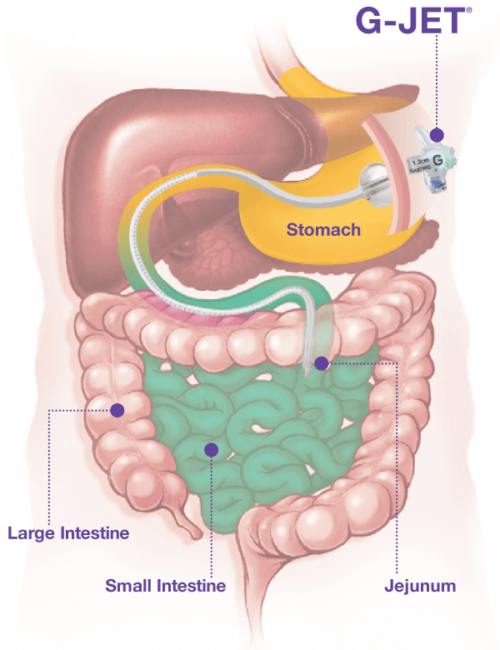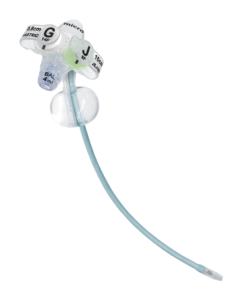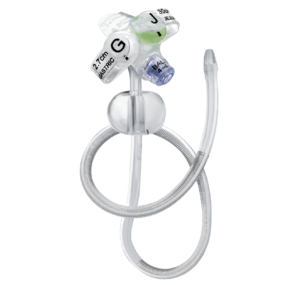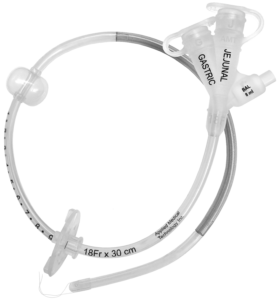G-JET® Family of GJ-Tubes
The G-JET® Family of GJ-Tubes
The More Comfortable Alternative for Enteral Feeding

A Gastric-Jejunal Tube, also known as a GJ-Tube, has two ports: the gastric port (g-port) goes to the stomach and is most commonly used for delivering medication, draining excess fluids, or venting air; the jejunal port (j-port) goes to a section of the small intestine called the jejunum and is used to deliver nutrition. The device is placed through the abdominal wall, into the stomach, and then passes out of the stomach into a part of the small intestine called the jejunum.
AMT offers two low profile Gastric-Jejunal Tubes called the micro G-JET® and G-JET® Button. AMT also offers a Traditional Length Gastric-Jejunal Tube called the Traditional G-JET®.
Low profile refers to the external portion of the device, often called the bolster, being very flat or flush against the skin. Due to this flat design, these devices can easily be hidden under your clothes. Low profile tubes are often called “buttons.”
Traditional length means that the external portion of the device is long and extends from the body. These tubes are sometimes called “long tubes,” “adjustable length tubes,” “standard length tubes,” and even “danglers.” Traditional length devices have a round disc, or retention ring, for the external bolster. The disk can be moved up and down the tube to accommodate changes in stoma length. Traditional length devices typically accommodate stoma lengths up to 10 cm. The disk/ring on AMT’s devices has small “feet” to keep it from touching too much skin at one time. The small “feet” allow the skin around the stoma site to stay dry and open to the air, which can help prevent infection.
A GJ-Tube, like the G-JET®, is recommended for people who cannot eat by mouth and have a stomach that does not work properly. These patients need to administer nutrition directly into the small intestine – the GJ-Tube allows them to do that! You can think of the GJ-Tube as being two tubes in one. The first tube ends in the stomach, and the second tube ends in the small intestine (specifically, the jejunum).
The low profile micro G-JET® Button was designed to meet the enteral nutrition needs of pediatric patients. The micro G-JET® transitions from a 14F gastric segment to an 8F jejunal segment. The 8F jejunal tubing is well-suited for the narrow lumen of the small intestine in pediatric patients and was designed to reduce digestive problems associated with sustained pyloric opening, such as reflux and potential aspiration of bile or chyme.
The micro G-JET® is available in 14F with stoma lengths ranging from 0.8 cm to 2.5 cm and with jejunal lengths ranging from 10 cm to 30 cm.
The low profile G-JET® Button offers reduced clogging, anti-kink technology, improved comfort, and safety in innovation. The G-JET® is made from medical-grade silicone to reduce skin irritation and improve patient comfort. The low profile external bolster is soft and flexible, making it easy to clean.
The G-JET® is available in 14F, 16F, and 18F with varying gastric stoma lengths ranging from 1.0 cm to 6.0 cm and jejunal lengths ranging from 15 cm to 45 cm.
The adjustable length Traditional G-JET® offers reduced clogging, our exclusive balloon, and improved comfort. The 16F and 18F Traditional G-JET® devices include anti-kink technology. The Traditional G-JET® is made from medical-grade silicone to reduce skin irritation and improve patient comfort.
The Traditional G-JET® is available in French sizes 14F, 16F, 18F, and 22F, with jejunal lengths ranging from 15 cm to 45 cm. The adjustable bolster can accommodate gastric stoma lengths up to 10 cm.



